Latin America is widely known for its rich bird life, which is characterized by a diverse mix of avian species. The region is home to more than 3,000 species of birds, which is around 30% of the world’s avian population.
From the tropical rainforests of the Amazon to the high Andes mountain range and the coastal wetlands, there is an impressive array of habitats where birds flourish in Latin America.
However, the conservation of these birds and their habitats is becoming increasingly difficult due to the rapidly growing human population in the region.
Despite this challenge, Latin America remains a fascinating and essential destination for bird-watchers and ornithologists from around the world. This article explores the incredible diversity of birds in Latin America and the current conservation challenges they face.
1. Toco Toucan
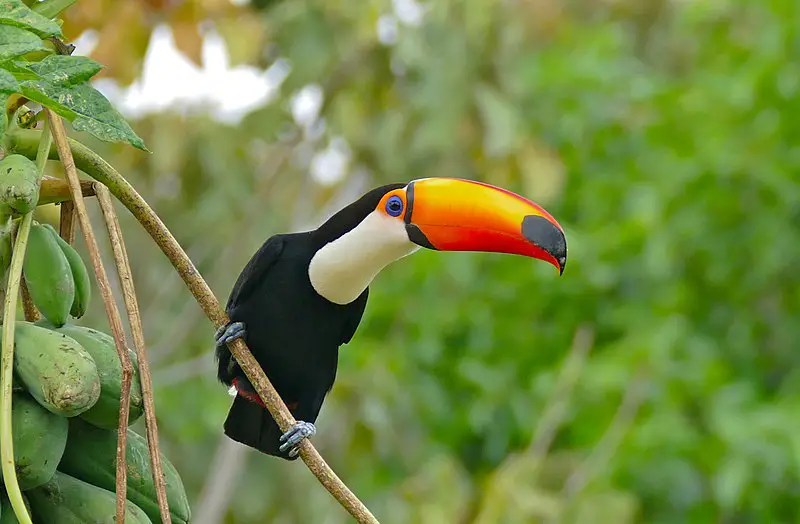
The Toco Toucan is the largest and most recognizable species of toucans, native to semi-open habitats in Central and Eastern South America.
First described by German zoologist Philipp Ludwig Statius Müller in 1776, this colorful bird has two subspecies – Ramphastos toco toco and Ramphastos toco cuvieri – distinguished by their slightly different size, plumage coloration, beak markings and range.
With its large orange bill covered with black spots along the sides of its face contrasting with yellow feathers on top of its head , it’s a very striking animal indeed.
Commonly found in zoos around the world too due tot heir loveable nature they are often kept as pets. They feed mainly on fruit but may also eat insects or small reptiles from time to time.
All in all these birds provide us a wonderful spectacle that we should appreciate for many years ahead.Scientific classification:
| Kingdom | Animalia |
| Phylum | Chordata |
| Class | Aves |
| Order | Piciformes |
| Family | Ramphastidae |
| Genus | Ramphastos |
| Species | R. toco |
Also Featured In: Beautiful Brazilian Birds, Birds That Live in the Jungle
2. Hyacinth Macaw
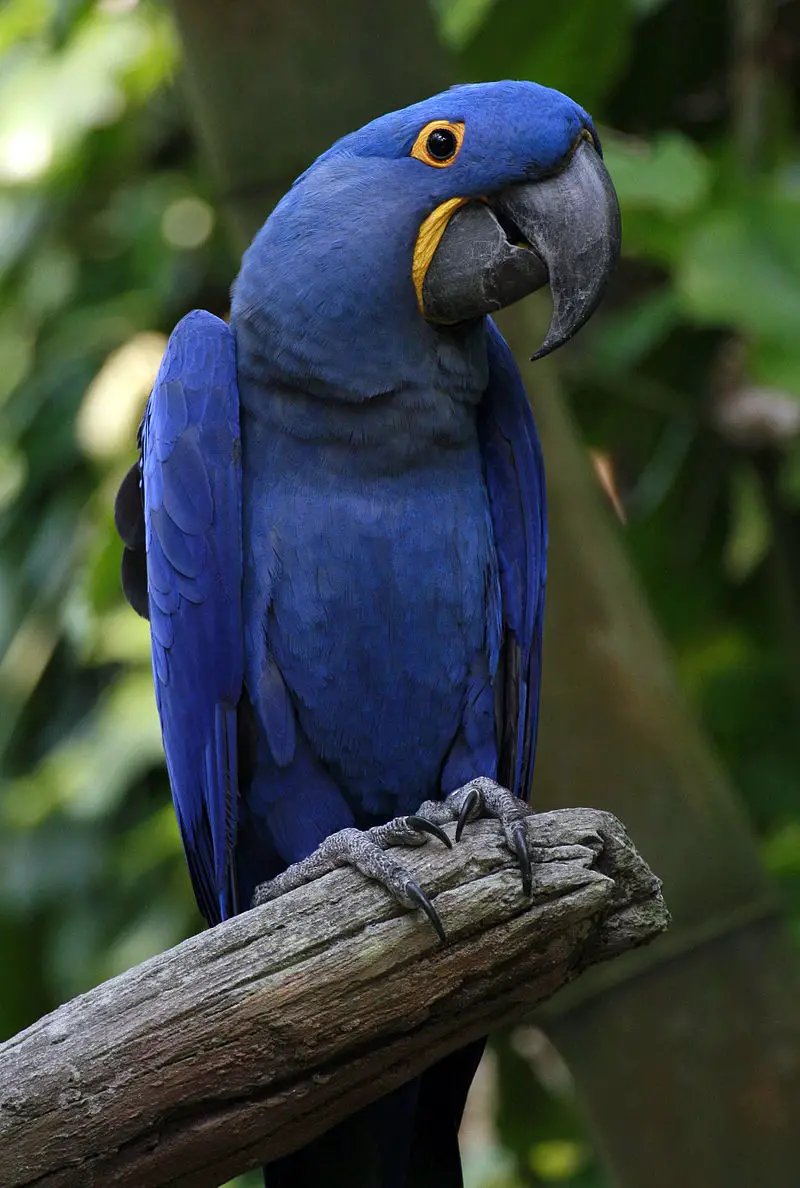
The Hyacinth Macaw is an extraordinary bird, known for its impressive size and vibrant coloration.
It has a length of around one meter, making it the longest parrot species in existence as well as the largest flying parrot species; even larger than 3.5 kg flightless Kākāpō from New Zealand.
Its striking blue plumage with yellow at its wingtips gives this majestic bird an eye-catching appearance that’s sure to turn heads wherever it goes.
Native to central and eastern South America, these birds are highly intelligent creatures who form strong bonds with their owners when kept in captivity.
They make great companions if given proper care and attention which includes providing them with plenty of space for exercise and enrichment activities such as playtime out of the cage on occasion or teaching them tricks using positive reinforcement methods like verbal praise or food rewards.Scientific classification:
| Kingdom | Animalia |
| Phylum | Chordata |
| Class | Aves |
| Order | Psittaciformes |
| Family | Psittacidae |
| Genus | Anodorhynchus |
| Species | A. hyacinthinus |
Also Featured In: Blue Birds You’ll Found around Us, Rainforest Birds You Should Know
3. Rufous-Bellied Thrush
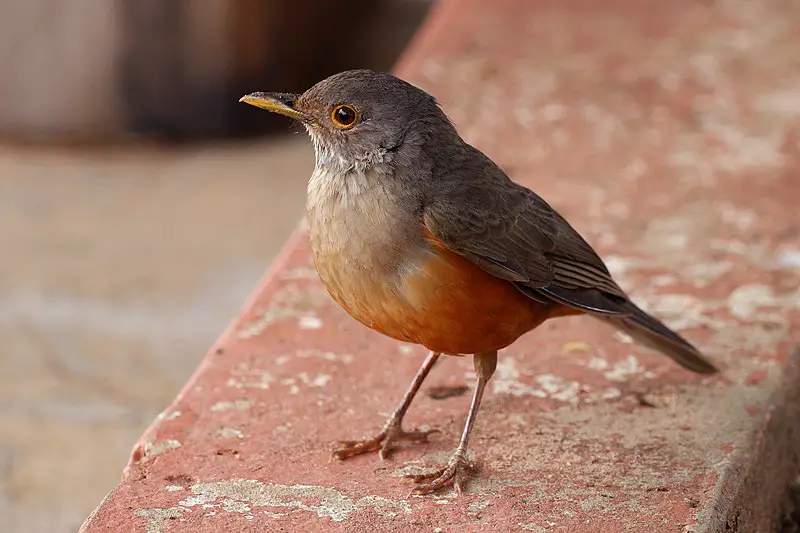
The Rufous-bellied Thrush is a songbird of the Turdidae family, commonly found in Brazil, Bolivia, Paraguay, Uruguay and parts of Argentina. It has brownish orange feathers on its back and throat while it’s underside is bright yellow.
This species likes to inhabit open woodland areas such as lowland evergreen forests or mangroves where they feed on insects like beetles, ants and caterpillars.
They are also known for their beautiful songs which consist of whistles with staccato notes at the end that make them easily identifiable amongst other thrushes.
The populations have remained relatively stable over time but due to deforestation there has been some decline in numbers so conservation efforts need to be implemented if we want this species around for many more years to come.Scientific classification:
| Kingdom | Animalia |
| Phylum | Chordata |
| Class | Aves |
| Order | Passeriformes |
| Family | Turdidae |
| Genus | Turdus |
| Species | T. rufiventris |
Also Featured In: Most Common Birds in South America Birds,
4. Hoatzin
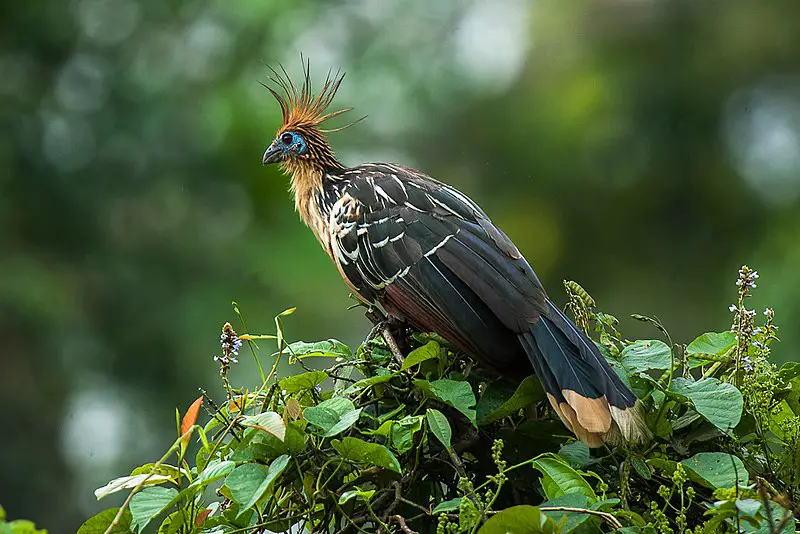
The Hoatzin bird is a tropical species found in the Amazon and Orinoco river basins of South America. It inhabits swamps, riparian forests and mangroves.
This unique bird has chicks that have claws on two of their wing digits which make it the only member in its order – Opisthocomiformes.
Its most distinctive feature is an odour produced from its digestive system which smells like cow manure.
The adults are brownish-grey with blue facial skin, red eyes, pointed crest feathers and black primaries.
They feed mainly on leaves but also eat flowers, fruits or buds when available during different seasons.
They can be heard making loud calls resembling caws at night time as well as repeated whistles throughout the day to keep contact between family members within flocks.Scientific classification:
| Kingdom | Animalia |
| Phylum | Chordata |
| Class | Aves |
| Order | Opisthocomiformes |
| Family | Opisthocomidae |
| Genus | Opisthocomus Illiger, 1811 |
| Species | O. hoazin |
Also Featured In: Common Tropical Rainforest Birds, Birds that Live in Guyana
5. Southern Lapwing
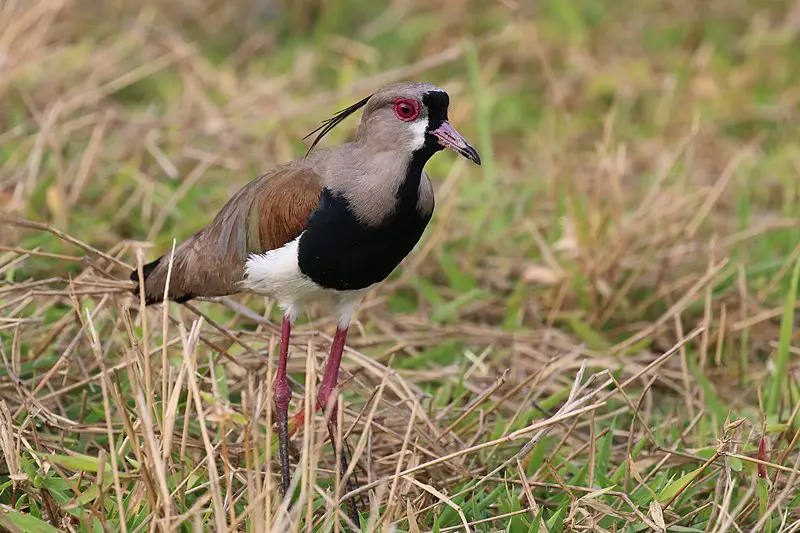
The Southern lapwing, also known as quero-quero in Brazil or tero in Argentina and Uruguay, is a wader that can be found throughout South America.
It inhabits open areas like grasslands and fields but avoids heavily forested regions such as the Amazon basin.
This bird has an unmistakable appearance with its black-and-white plumage contrasting against its bright yellow bill and legs.
The male’s feathers are more vibrant than those of the female, making them easily distinguishable from each other.
They feed on worms and insects which they search for by probing their long bills into soft ground while walking around looking for food.
Lapwings are highly territorial birds who will protect their nests fiercely from any potential predators or intruders.Scientific classification:
| Kingdom | Animalia |
| Phylum | Chordata |
| Class | Aves |
| Order | Charadriiformes |
| Family | Charadriidae |
| Genus | Vanellus |
| Species | V. chilensis |
Also Featured In: Patagonia Birds You Should Know,
6. Andean Cock-Of-The-Rock
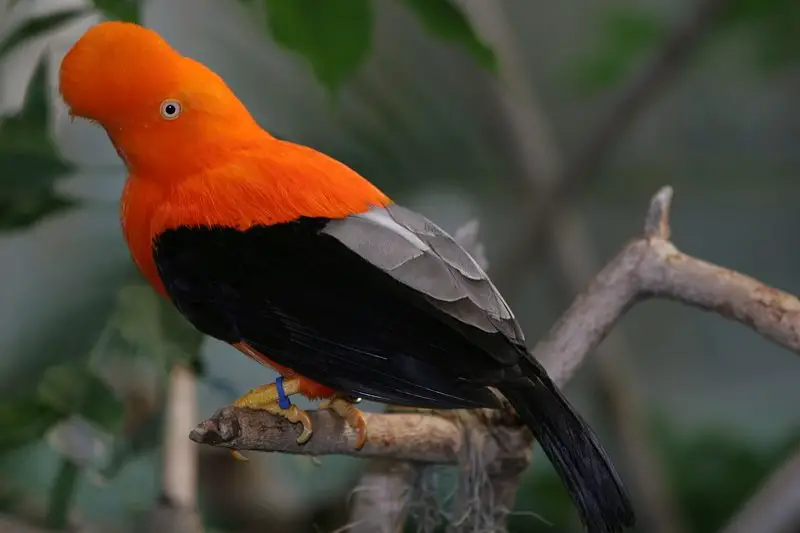
The Andean cock-of-the-rock is a large passerine bird belonging to the Cotinga family. It has four subspecies and can be found in the cloud forests of South America, notably Peru where it has been declared its national bird.
This species exhibits marked sexual dimorphism; males have an impressive orange crest that covers most of their head as well as a bright coral chest patch while females are mainly grey with dark wings and tail feathers.
Both sexes also feature black heads, yellow eyes, long bills and short legs.
Their diet consists mostly of fruits but they have also been known to eat small insects for protein.
They are monogamous birds who mate for life forming strong pair bonds that last several years until one partner dies or moves away from its territory.Scientific classification:
| Kingdom | Animalia |
| Phylum | Chordata |
| Class | Aves |
| Order | Passeriformes |
| Family | Cotingidae |
| Genus | Rupicola |
| Species | R. peruvianus |
Also Featured In: Common Birds in Colombia,
7. Andean Condor
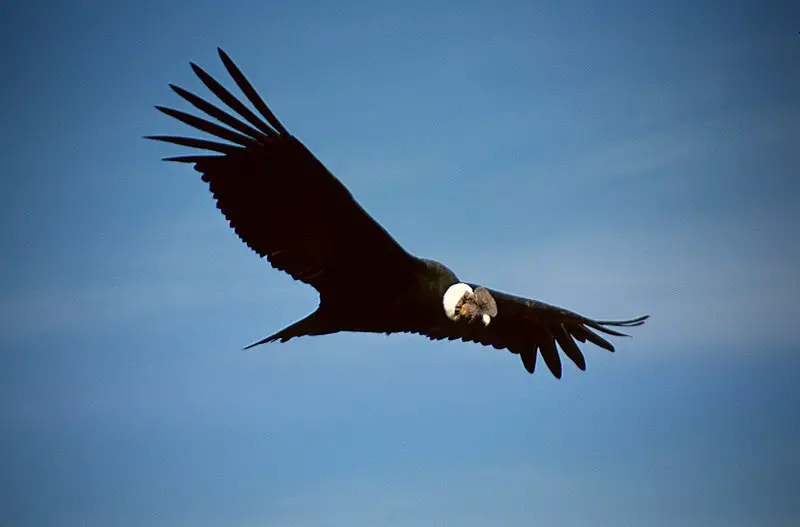
The Andean condor is a giant South American Cathartid vulture and the only member of its genus.
Found in the Andes mountains and along Pacific coasts, it is thought to be the largest flying bird on Earth by weight and wingspan with a maximum wingspan reaching up to 10 feet 10 inches (3.3 m) and weighing 33 lbs (15 kg).
It has mainly black plumage which helps keep it warm at high altitudes, while white patches adorn its head, neck, chest as well as underwing coverts.
Its powerful bill allows it to consume carrion efficiently while also being able to crack bones for nutrition when necessary.
The amazing flight capabilities of this majestic creature allow them soar through air thermals effortlessly; making them an impressive sight against clear blue skies.Scientific classification:
| Kingdom | Animalia |
| Phylum | Chordata |
| Class | Aves |
| Order | Accipitriformes |
| Family | Cathartidae |
| Genus | Vultur Linnaeus, 1758 |
| Species | V. gryphus |
Also Featured In: Aviary Birds You Should Know, Flight Birds You Should Know
8. Keel-Billed Toucan
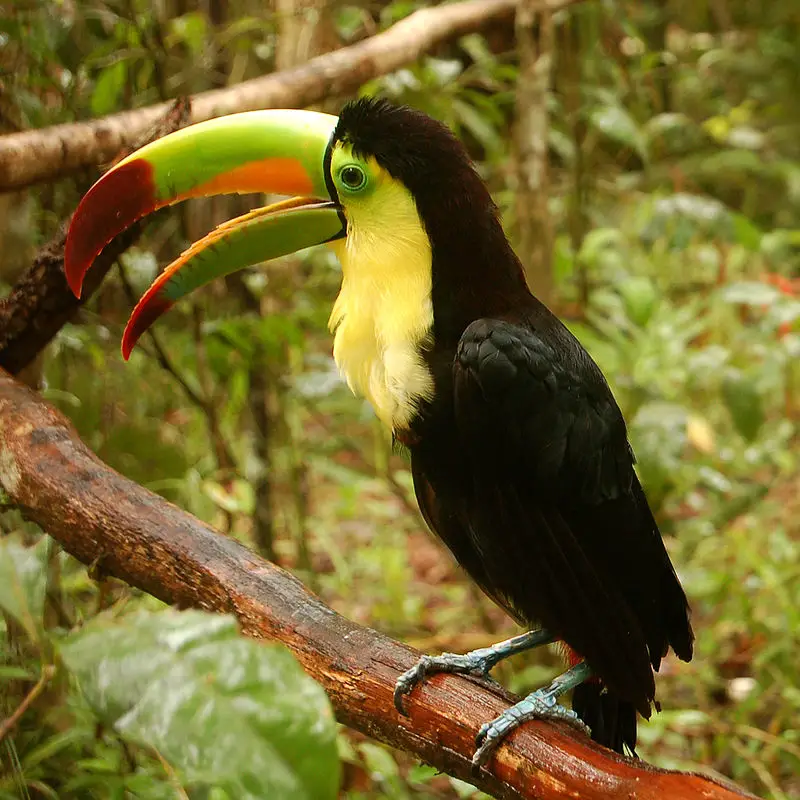
The Keel-billed Toucan is a vibrant Latin American bird from the toucan family and also serves as Belize’s national bird. They are found in tropical jungles stretching all the way from southern Mexico to Colombia.
They feed on fruits, seeds, insects, lizards and snakes – being omnivorous birds they eat pretty much anything.
These colourful creatures have an impressive beak with green upper parts of their bodies coupled with yellow lower halves.
The underside of their tail feathers are black while its tips remain white creating for quite a stunning display when flying or perched atop tree branches.Scientific classification:
| Kingdom | Animalia |
| Phylum | Chordata |
| Class | Aves |
| Order | Piciformes |
| Family | Ramphastidae |
| Genus | Ramphastos |
| Species | R. sulfuratus |
9. Harpy Eagle
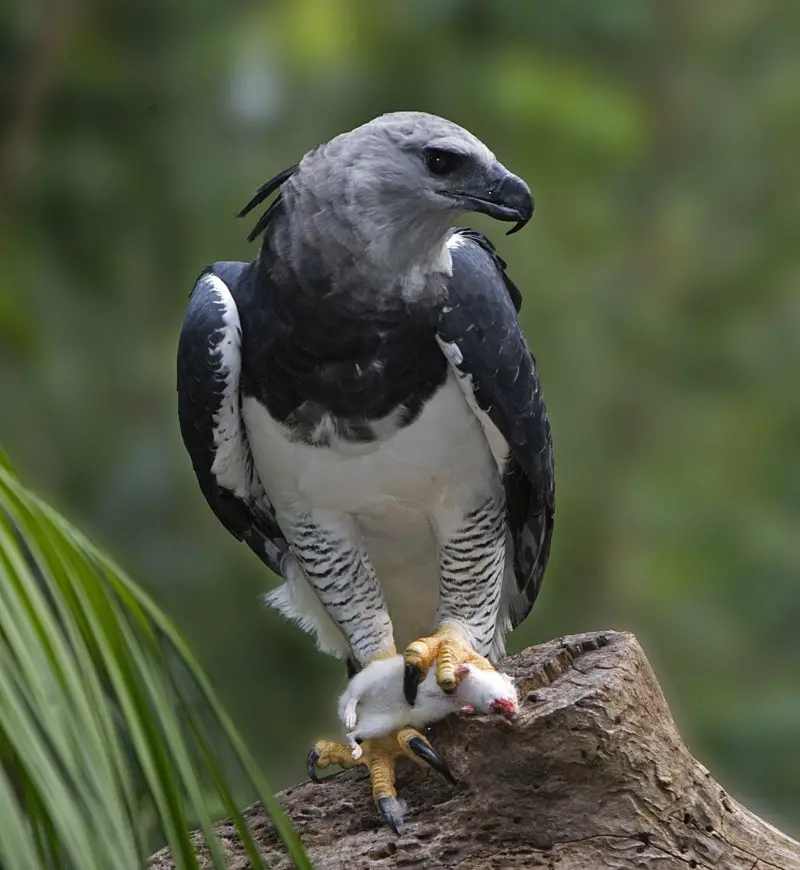
The Harpy Eagle is a magnificent bird of prey found in the tropical forests of Central and South America. It is the largest eagle on Earth, possessing an impressive wingspan that can reach up to 7 feet across.
Its powerful talons are its most distinguishing feature, being able to grasp even large animals such as monkeys or sloths with ease.
The majestic raptor has slate-gray feathers on its back and head which contrast against white undersides and yellow legs.
These birds live alone for much of their life but will come together during breeding season when they construct elaborate nests high off the ground in tall trees.
People have long been fascinated by this species’ impressive size and strength—it truly deserves its nickname as “the lord of skies”.Scientific classification:
| Kingdom | Animalia |
| Phylum | Chordata |
| Class | Aves |
| Order | Accipitriformes |
| Family | Accipitridae |
| Subfamily | Harpiinae |
| Genus | Harpia Vieillot, 1816 |
| Species | H. harpyja |
Also Featured In: Birds You’ll Find in Zoo, Common Carnivore Birds
10. Rufous Hornero
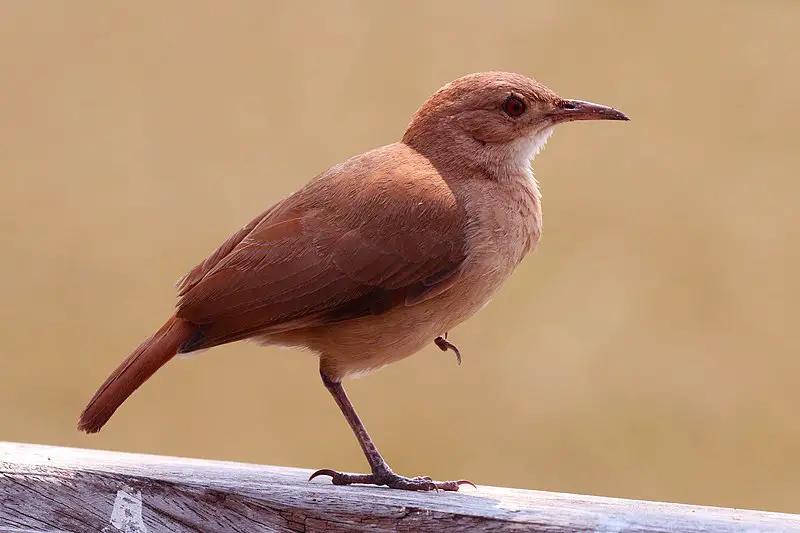
The Rufous Hornero is a small ovenbird found in eastern South America and is the national bird of Argentina. It has adapted to human environments such as pastures, agricultural land and second-growth scrub areas, making it synanthropic.
Its range stretches from midwestern Brazil to southern Bolivia, Paraguay, Uruguay and northern Argentina.
The species is easily identifiable by its rusty red plumage with dark streaks on the back of its neck along with white underparts that have black spots near their edges.
This medium-sized bird has impressive mud dome nests at top of trees or artificial structures like power poles where they lay two eggs each season which are incubated for about three weeks until hatching takes place.
They feed mainly on insects but also eat fruits when available during winter monthsScientific classification:
| Kingdom | Animalia |
| Phylum | Chordata |
| Class | Aves |
| Order | Passeriformes |
| Family | Furnariidae |
| Genus | Furnarius |
| Species | F. rufus |
Also Featured In: Birds of Argentina, Birds that Make Mud Nests
11. Waved Albatross
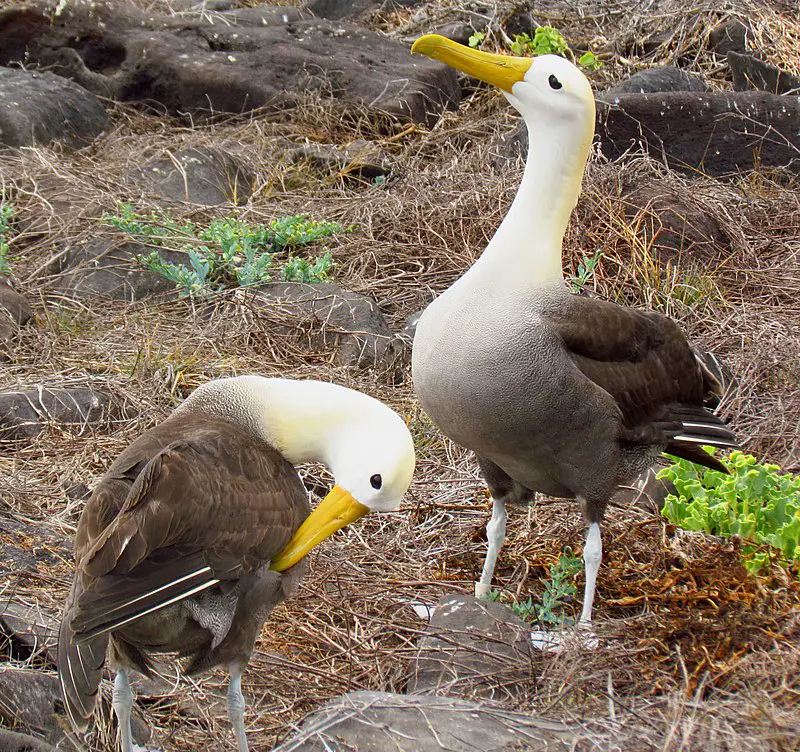
The Waved Albatross is a stunning bird with distinctive black and white plumage. It is the only species of its family Diomedeidae that inhabits in tropical regions.
During breeding season, they can be found mostly near Ecuadorian and Peruvian coasts while during non-breeding season they travel up to 1,000 km east towards Peru’s coastline foraging food.
These birds are graceful gliders soaring through the skies using their long wingspans to navigates winds effortlessly when searching for prey like fish or squid at sea surface.
They also have an impressive courtship ritual involving head nodding which was once thought extinct but thankfully has been sighted again on Galapagos islands recently.Scientific classification:
| Kingdom | Animalia |
| Phylum | Chordata |
| Class | Aves |
| Order | Procellariiformes |
| Family | Diomedeidae |
| Genus | Phoebastria |
| Species | P. irrorata |
Also Featured In: Most Unique Birds in Peru, Galapagos Birds You Should Know
12. Venezuelan Troupial
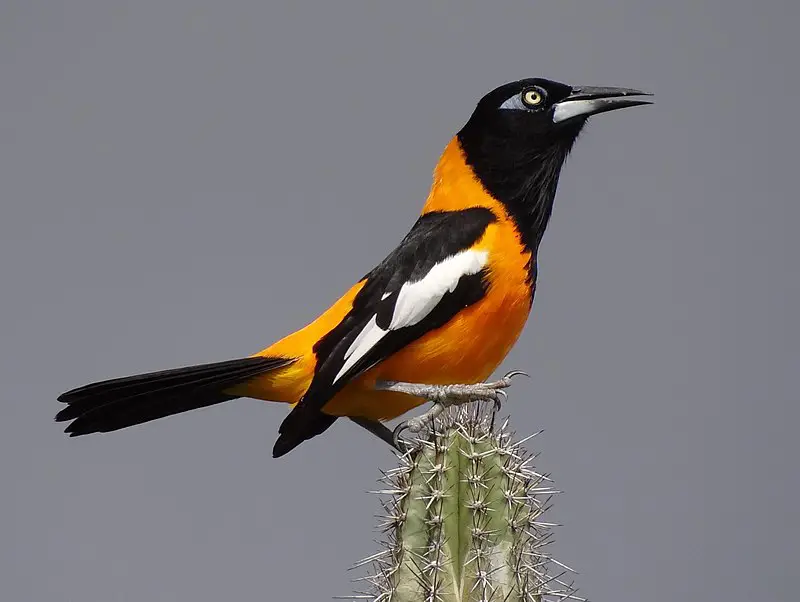
The Venezuelan troupial (Icterus icterus) is Venezuela’s national bird and can be found in Colombia, Venezuela and some Caribbean islands such as Aruba, Curaçao, Bonaire, Trinidad and Puerto Rico.
It was previously part of a superspecies known simply as the troupial with the orange-backed troupial and Campo troupial but has since been split off.
The name ‘troupial’ comes from French ‘toupiare’, which means “troop” due to their tendency to gather in flocks outside of breeding season.
They are medium sized birds with males being slightly larger than females – both have black bodies that contrast against a bright yellow head or crest.
Their wingspan averages at around 35cm long making them quite agile flyers when they migrate each year between November to April for warmer climates.Scientific classification:
| Kingdom | Animalia |
| Phylum | Chordata |
| Class | Aves |
| Order | Passeriformes |
| Family | Icteridae |
| Genus | Icterus |
| Species | I. icterus |
Also Featured In: Birds of Venezuela, Birds that You’ll Find in Puerto Rico
13. Resplendent Quetzal
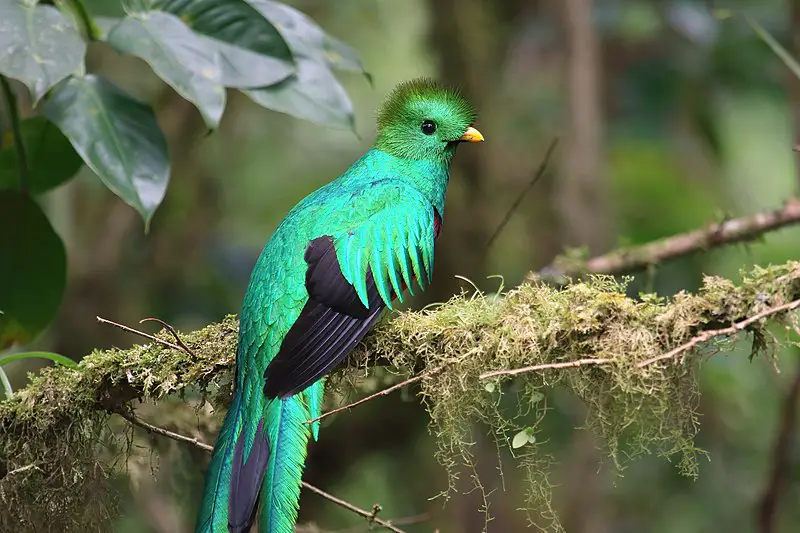
The resplendent quetzal is a beautiful and vibrant bird found in Central America. It belongs to the family Trogonidae, which includes birds like trogons and motmots.
This species of quetzal has two recognized subspecies: P. mocinno and P. costaricensis, both living in tropical forests such as montane cloud forests.
They are omnivores, typically eating fruits from various plants along with insects, lizards or eggs when available.
The male’s plumage is particularly striking with its multi-colored feathers ranging from green to blue to red that gives it its namesake “resplendence” look.
This coloration comes at a price for males because their bright colors make them more visible predators than females who have duller brown coloring instead.
Regardless of gender though all members of this species demonstrate great agility in flight due to their long tails which help stabilize them even through tight turns.Scientific classification:
| Kingdom | Animalia |
| Phylum | Chordata |
| Class | Aves |
| Order | Trogoniformes |
| Family | Trogonidae |
| Genus | Pharomachrus |
| Species | P. mocinno |
Also Featured In: Most Beautiful Birds in Guatemala, Birds that You’ll Find in Chiapas
14. Blue-Footed Booby

The blue-footed booby is a marine bird that can be found in subtropical and tropical parts of the eastern Pacific Ocean.
It’s one of six species from the same genus, with its unique bright blue feet being a product of their diet as well as an attractive mating ritual for males.
During this ritual, they lift up their feet to show off their brilliant colouring to potential mates.
Boobies are excellent divers, using these skills primarily to hunt fish and squid close by reefs or open ocean waters – plunging into the sea from heights between 10–30 metres.
They also feed on smaller prey such as crustaceans which float near the surface.
Their wingspan averages 1 metre across, making them graceful flyers over large distances both on land and above water surfaces alike.Scientific classification:
| Kingdom | Animalia |
| Phylum | Chordata |
| Class | Aves |
| Order | Suliformes |
| Family | Sulidae |
| Genus | Sula |
| Species | S. nebouxii |
Also Featured In: Birds of Ecuador, Birds You’ll Find in the Sea
15. Cuban Trogon

The Cuban Trogon is a species of bird belonging to the family Trogonidae. Endemic to Cuba, it serves as the national bird and has two subspecies: P. t. temnurus and P. t. vescus.
The Cuban Trogon stands out due to its beautiful plumage; they have an overall green body with yellow underparts, blue wings that are tipped in white, a red forehead and throat patch along with blackish gray feathers on their back marking them distinctively from other birds around them.
They inhabit humid forests located near rivers or swamps where they feed mainly on insects such as beetles & butterflies supplemented by some fruit & nectar intake too.
Their loud call can be heard during dusk especially when searching for mates or establishing territories – making sure that everyone knows these gorgeous birds live here.Scientific classification:
| Kingdom | Animalia |
| Phylum | Chordata |
| Class | Aves |
| Order | Trogoniformes |
| Family | Trogonidae |
| Genus | Priotelus |
| Species | P. temnurus |
Also Featured In: Most Common Types of Birds Found in Cuba,
16. Turquoise-Browed Motmot

The turquoise-browed motmot is a beautiful bird of the Momotidae family. It can be found in central America from south east Mexico to Costa Rica, where it is common and not considered threatened.
This species enjoys living in open habitats such as forest edges, gallery forests or scrubland.
They are more visible than other Motmots due to their large size and bright colouration which includes an iridescent blue back and yellowish chest with black spots on its throat feathers.
Turquoise-browed motmots possess unique features that set them apart; they have two long tail feathers which dangle behind them while flying like streamers, hence earning themselves the nickname “the flying orchestra”.
In addition they are known for their loud calls during mating season – making them easily recognizable.Scientific classification:
| Kingdom | Animalia |
| Phylum | Chordata |
| Class | Aves |
| Order | Coraciiformes |
| Family | Momotidae |
| Genus | Eumomota P.L. Sclater, 1858 |
| Species | E. superciliosa |
Also Featured In: Birds of Honduras, Birds that Live in Tabasco
17. Bare-Throated Bellbird

The bare-throated bellbird is a species of bird found in moist subtropical and tropical forests in Argentina, Brazil, and Paraguay. Its male counterpart has striking white plumage with bluish-black skin around its eye, beak and throat.
The female is more drab with olive-brown upperparts contrasting against streaked yellow underparts.
One of the most impressive qualities of this bird however is its astounding vocal range – it can produce one of the loudest sounds amongst birds.
It’s song consists mainly of deep tones which when combined form an incredible melodic sound that resonates through their forest habitats.
This truly remarkable creature should definitely be appreciated for both its beauty as well as its unique call.Scientific classification:
| Kingdom | Animalia |
| Phylum | Chordata |
| Class | Aves |
| Order | Passeriformes |
| Family | Cotingidae |
| Genus | Procnias |
| Species | P. nudicollis |
Also Featured In: Most Common Birds In Paraguay,
18. Clay-Colored Thrush

The Clay-colored Thrush is a common Middle American bird belonging to the thrush family. It has become known as Costa Rica’s national bird, going by the name yigüirro in Spanish.
Not only does it inhabit South Texas and parts of northern Colombia, but its range extends westward and northward from Isthmus Tehuantepec too.
It has an overall buffy coloration with brownish upperparts which help distinguish this species from other birds within its habitat.
Additionally, some individuals have white tips on their tail feathers that further serve to differentiate them amongst others of their kind.
This hardy species continues to thrive in many different habitats across Central America making it one of the most widespread songbirds around.Scientific classification:
| Kingdom | Animalia |
| Phylum | Chordata |
| Class | Aves |
| Order | Passeriformes |
| Family | Turdidae |
| Genus | Turdus |
| Species | T. grayi |
Also Featured In: Costa Rica Birds, Birds You’ll Find in South Texas